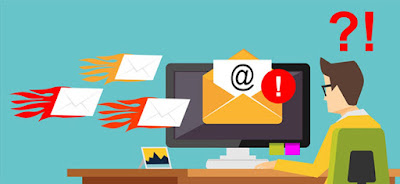WHAT IS EMAIL BOMBARDMENT?


Phishing remains the preferred method of cybercrime. According to the 2019 Phishing and Fraud Report, carried out by the F5 Networks research center, in the United States, phishing represents 21% of the methods used by attackers because it is easy and it works.
Attackers don't have to worry about hacking into a firewall, finding a zero-day exploit, cracking an encryption; the hardest part is slipping a good trick into the email to get people to click and create a fake site to land on.
And to make the deception more effective, the malicious
sites to which the emails are redirected are usually copycats of popular brands
or platforms.
How
to avoid being misled by fraud while working from home or simply while being
distracted by current events?
Especially during fast-paced and uncertain events,
criminals count on distractions. They are taking advantage of it to sneak into
a scam. Whether it's leveraging the increased volume of online shopping, the
increased use of online education and 'meeting' software, or the increased need
for pandemic information and critical infrastructure, attackers may be seeing
results.
We have seen scams related to vaccine scheduling,
hospital systems locked with ransomware, and a DDoS attack against Health
Departments.
While most organizations have systems in place to detect
and quarantine such email scams, monitoring them will make them even more
effective. However, these systems can never be 100% perfect, and you can find
cybercrime scams through other channels, such as your personal email accounts
In this regard, there is information on the largest number of organized online fraud schemes as a result of COVID-19, and the security measures that an organization can take to not fall so easily into the clutches of phishing:
Check
the sender's email address.
• Click on the return address and verify that it is from
a reliable source.
Think twice before clicking on the links or downloading
attachments.
• Be careful opening email attachments and / or clicking
on email links or links in text messages from unknown sources.
• Be sure to check the domains that are linked, to make
sure they are trustworthy and familiar domains.
• Make sure to avoid using or clicking on shortened URLs,
such as those from services like Bit.ly, as these hide the real target website.
• If you clicked the link or downloaded an attachment,
please do not provide any information on the website and the opening.
Don't click on links within suspicious emails or text
messages.
• If you receive an email or text message asking you to
log into an online account through a link provided, instead of clicking the
link, open a browser and go directly to the company's website.
View
trusted sources and websites.
• Beware of malicious or compromised websites. The
initial (domain) part of a website address should represent the company that
owns the site you are visiting.
Check
the domain for misspellings.
• Sites that aggressively open pop-ups and display
deceptive buttons often entice users to accept content through constant
pop-ups.
Keep
your software up to date.
• Download the latest version of your web browsers and
applications and keep updated antivirus.
• This also applies to home computers. Keeping the
operating system and third-party applications up-to-date is an important action
to keep your computer safe.
Protect
your personal information.
• When you need to provide personal information, whether
in a web form, email, text message, or phone message, think about why someone
needs it and whether you can really trust the request.
From the web,
stick with sites that use encryption to protect your information.
Lastly, look for
https at the beginning of the trusted web address.
Comments
Post a Comment